Samsung Galaxy Tab S7 review: The best iPad Pro rival yet
The Samsung Galaxy Tab S7 is an Android tablet iPad users should feel right at home with. Picking it up made me want to say “It’s an iPad Pro, but for Android,” and it’s not hard to see why. While working on this Galaxy Tab S7 review, I immediately realized the similarities, as its machined aluminum chassis, beautiful screen and sweet-sounding speakers make it a serious challenger to the best iPad.
But the Tab S7 doesn’t just stand in Apple’s shadow. The Tab S7’s battery life beats the iPad Pro’s, and that’s just one of the reasons why the Galaxy Tab S7 is one of the best Android tablets around, and one of the best tablets overall, its awkward keyboard cover and not-great performance puts a ceiling on how high it can go.
And while we’re still testing the Lenovo Tab P11 (early awaiting our results) as it looks like a noteworthy contender in the Android tablet space. Just closer to the Galaxy Tab A7 than the Tab S7.
But if you’re looking for what’s next in the Samsung tablet world, check out our guide for everything we’ve learned about the Samsung Galaxy Tab S8 from the rumor mill. For now, read on to see how Samsung’s catching up with Apple — including where the new iPad Air 2020 bets the Tab S7, and where Samsung has Apple’s number.
Samsung Galaxy Tab S7 review: Release date and price
The Galaxy Tab S7 and S7 Plus went on sale on Sept. 18, 2021, following pre-orders that have been live since Sept. 2. The Tab S7 starts at $649, while the Tab S7 Plus starts at $849.
On February 18, 2021, a new Mystic Navy color option will arrive for the Galaxy Tab S7/S7+. You can pre-order it now, prices start at the same $649 on Samsung.com.
For cellular connectivity, you’re going to be spending $100 more for LTE and $200 more for 5G. The LTE Galaxy Tab S7 costs $749, while the 5GB Tab S7 costs $849, and the LTE Tab S7 Plus goes for $949, while the 5G Tab S7 Plus costs $1,049.
AT&T and Verizon have both announced pricing for the 5G versions of the tablets that they’re selling. At AT&T, you can get the Galaxy Tab S7 5G for $849 (or $28.34 per month on a 30-month installment plan). Verizon is also selling the Galaxy Tab S7 5G for $849 ($35.41 per month over 24 months) as well as the $1,049 Galaxy Tab S7 Plus 5G ($43.74 a month over 24 months). Both T-Mobile and US Cellular plan to offer the tablets as well.
Just like the iPad Pro’s Smart Keyboard Folio and Magic Keyboard, the Book Cover and Book Cover Keyboard for the Galaxy Tab S7 cost extra. You’ll spend $199 (Tab S7) or $229 (Tab S7 Plus) for the Book Cover Keyboards, and $69 (Tab S7) and $79 (Tab S7 Plus) for the Book Cover cases. Both protect the docked S-Pen from falling off.
Samsung Galaxy Tab S7 vs S7 Plus: Specs compared
| Galaxy Tab S7 | Galaxy Tab S7 Plus | |
|---|---|---|
| Display | 11-inch 2560 x 1600-pixel TFT panel (up to 120Hz) | 12.4-inch 2800 x 1752-pixel Super AMOLED panel (up to 120Hz) |
| Processor | Qualcomm Snapdragon 865 Plus | Qualcomm Snapdragon 865 Plus |
| Storage | 128GB/256GB | 128GB/256GB |
| Memory | 6GB/8GB | 6GB/8GB |
| Cameras | Rear: 13MP & 5MP (Ultra Wide). Front 8MP | Rear: 13MP & 5MP (Ultra Wide). Front 8MP |
| Security | Facial recognition, fingerprint reader on side key | Facial recognition, fingerprint reader on display |
| Connectivity | 5G (optional), LTE (optional), Wi-Fi 6, Bluetooth 5.0 | 5G (optional), LTE (optional), Wi-Fi 6, Bluetooth 5.0 |
| Battery | 8,000 mAh | 10,090 mAh |
| Size | 10 x 6.5 x 0.2 inches | 11.2 x 7.3 x 0.2 inches |
| Weight | 1.1 pounds | 1.3 pounds |
The Galaxy Tab S7 and Galaxy Tab S7 Plus have similar internals, so you’re not sacrificing performance with your choice for a big slate or a smaller screen. Both run on the Qualcomm Snapdragon 865 Plus, which is expected to be 10% faster than the regular 865 chip.
But that’s not the biggest performance difference in the Tab S7, as this tablet is the first to market with 5G connectivity. Different Galaxy Tab S7 and S7 Plus models will have different amounts of memory and storage, but they start with 6GB of RAM and 128GB of storage.
Samsung Galaxy Tab S7 review: Design
The Galaxy Tab S7 is an all-screen tablet with thin bezels and an aluminum frame. Sold in Mystic Black, Mystic Silver and Mystic Bronze, this slate looks astonishingly similar to the 2018 and 2020 iPad Pros.
That’s not a bad thing, as when you whittle a tablet down to just its screen — which is exactly what we want — there’s little room for modifications. I currently like Samsung’s color options and Mystic finish a tad more than what Apple offers.
At 10 x 6.5 x 0.2 inches and 1.1 pounds, the 11-inch Galaxy Tab S7 is thinner and lighter than the Surface Pro 7 (0.3 inches thick, 1.7 pounds), though a hair heavier than the 11-inch iPad Pro (0.2 inches thick, 1 pound) and the 10.9-inch iPad Air 2020 (0.2 inches, 1 pound).
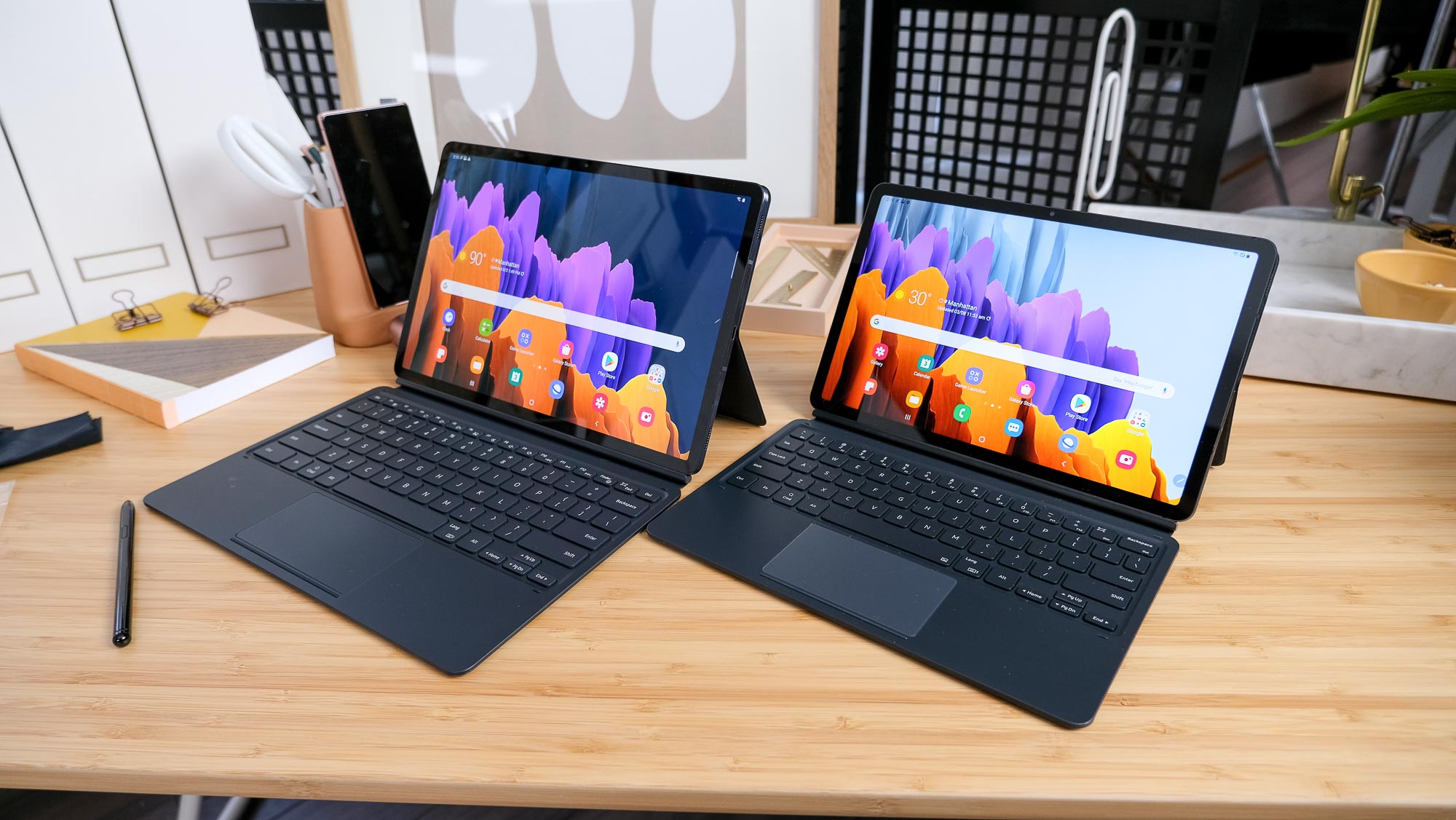
On the back, you’ve got a spot for the included S-Pen to magnetically dock and a small camera bump, which we’ll get to later.
There is a USB-C connector for power and data transfer on the right of the Tab S7, and on the top edge you’ve got a power button (which doubles as a fingerprint sensor) and the volume rocker. There’s also an SD memory reader for expanding local storage and a pogo connector on the bottom for docking Samsung’s optional Book Cover Keyboard.
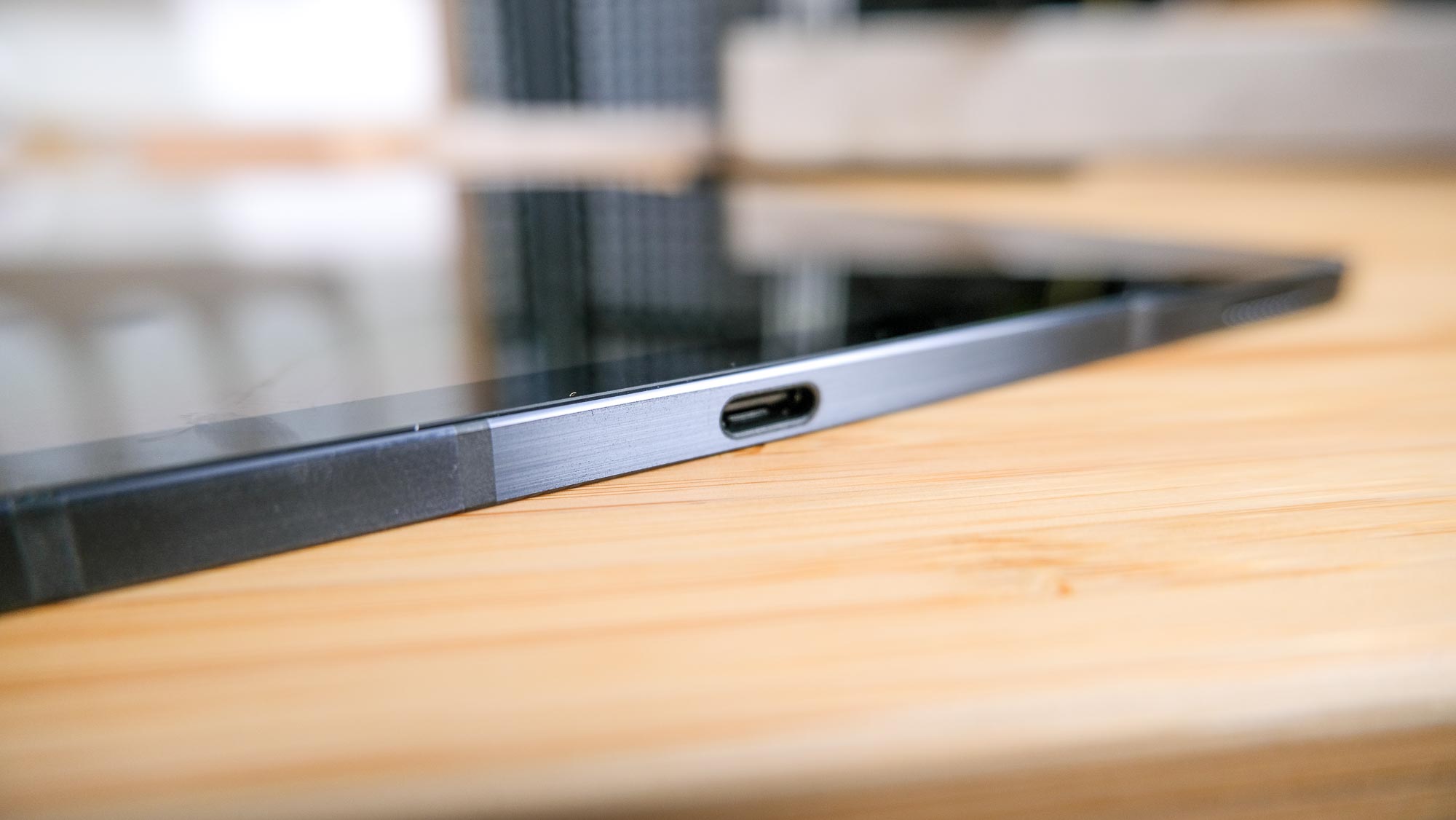
Samsung Galaxy Tab S7 review: Display
Watching a 4K nature video from YouTube, I was impressed by the Tab S7’s 2560 x 1600-pixel panel as I watched a hungry squirrel forage for food. Blades of grass and fur rendered equally crisply, while the browns of the animal’s fur and the greens of the flora looked both accurate and vibrant.
And while I saw only a smidge of glare in the screen as I watched that bright video, reflections intensified when I pulled up the dark and brooding trailer for The Mandalorian season 2. While I could still see WWE superstar Sasha Banks playing a Jedi, hidden in the shadows, all of the darker shots of the trailer showed me more of myself than of the trailer.
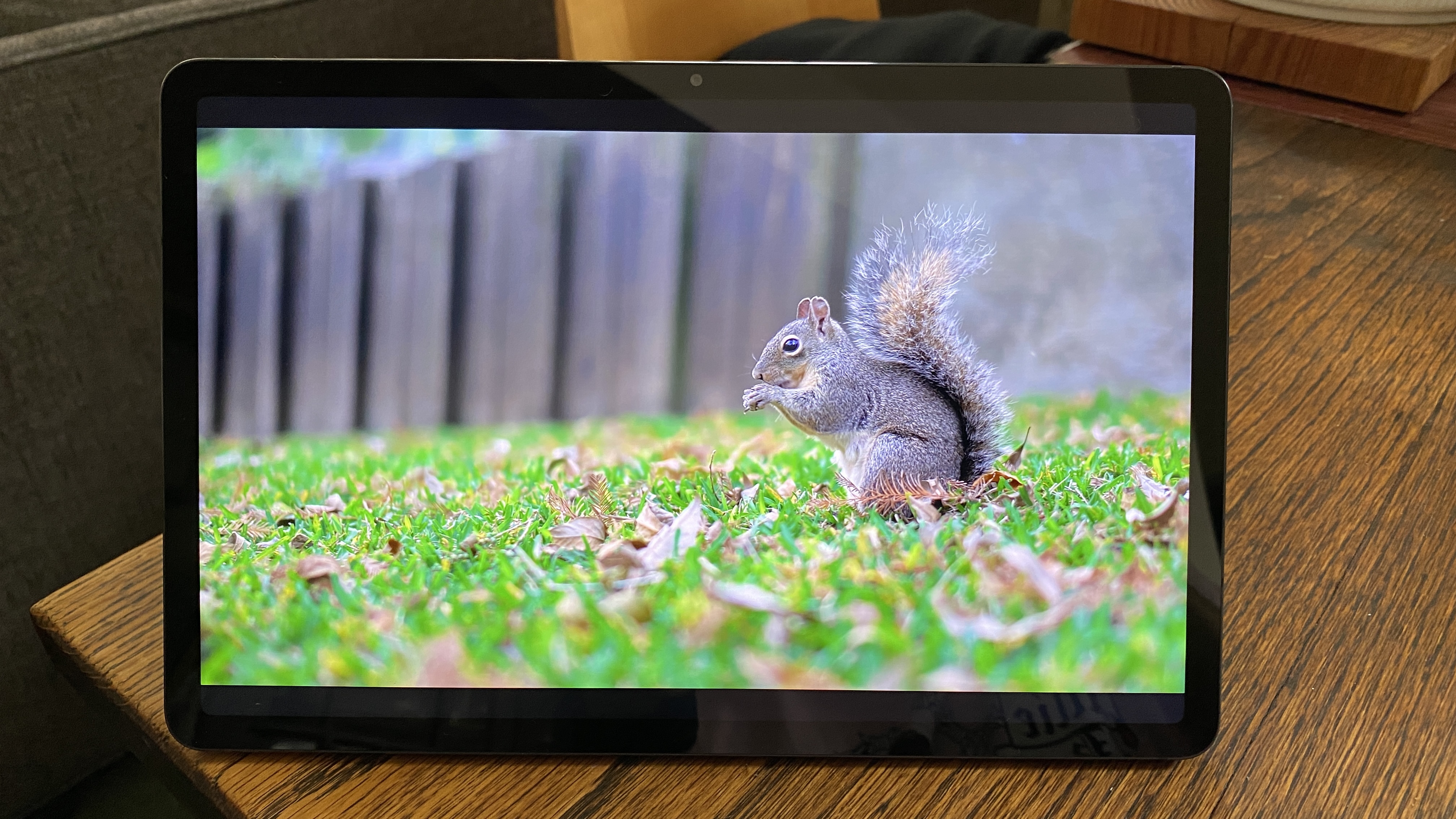
According to our Klein K10-A colorimeter, the Galaxy Tab S7 produces 152% of the sRGB color gamut in the Vivid screen mode that’s on by default, and 111% if you switch to Natural color.
Both numbers top the 97% rating from the Surface Pro 7, while the 123% rating from the 12.9-inch iPad Pro is somewhere in between, and the iPad Air 2020 hit 102.9%. That follows a pattern of Apple often going for more realistic color balance than Samsung’s default options.
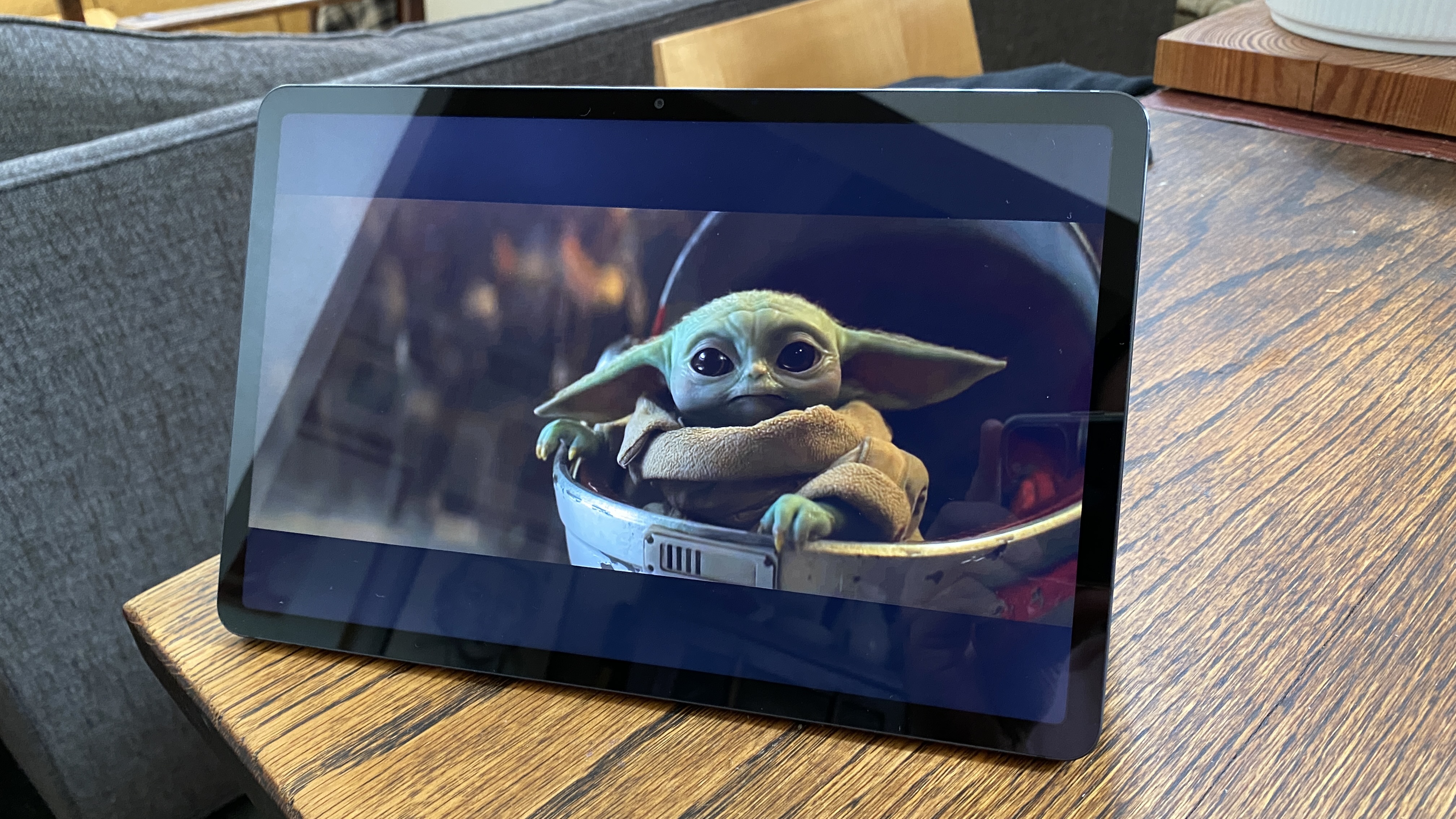
In terms of brightness, the Galaxy Tab S7 is rated for up to 500 nits of brightness, and we got incredibly close, with our colorimeter recording a max brightness of 499 nits. The 559-nit iPad Pro gets even brighter, while the 440-nit iPad Air 2020 and 395-nit Surface Pro 7 are dimmer.
The Galaxy Tab S7 has a smooth 120Hz display refresh rate (which the iPad Pro has and the Surface Pro does not), offering buttery smooth motion. To see it for myself, I enabled and disabled the setting (found in Settings > Display > Motion Smoothness) and watched as videos moved more smoothly and how text looked less pixelated when scrolling.
Samsung Galaxy Tab S7 review: Performance
The Qualcomm Snapdragon 865+ chip in the Tab S7 provided enough pep for multitasking, as I saw no lag (both in DeX mode and outside of it) when I split its screen between 12 Chrome tabs and a 1080p YouTube video. Spotify and Google Docs were running in the background, and both ran smoothly when I switched the active audio or went to take notes.
That being said, the Galaxy Tab S7’s Geekbench 5 multi-core score of 3,074 isn’t exactly anything to boast about. The A12Z-powered iPad Pro 2020 (4,635), A14 Bionic-based iPad Air (4,262) and the 10th Gen Core i5 Surface Pro 7 (4,878) notched scores that are notably higher than the Tab S7’s.
Asphalt 9 ran OK enough on the Galaxy Tab S7, though I did notice a stutter here and an anomaly there. I’m far from a racing game fan, but I still managed to nab first place as I sped a Mitsubishi around San Francisco.
Samsung Galaxy Tab S7 review: Audio
The Samsung Galaxy S7 pumps out the jams pretty well (you can make them sound better, too). Andre 3000’s vocals came through loud and clear on UGK’s “Int’l Player’s Anthem (I Choose You),” and I could hear a little bass and crisp cymbals clashing as the track’s multitude of drums hit, snapped and clapped.
For some reason, I couldn’t enable Dolby Atmos audio while in DeX mode, but when I switched back to normal mode and found the option (Settings > Sounds and vibration > Sound quality and effects > Dolby Atmos), it brought out more oompf for Cardi B and Bruno Mars’ “Please Me.”
Samsung Galaxy Tab S7 review: Cameras
I don’t really approve of using a tablet for photography, but the Galaxy Tab S7’s front-facing camera is great for video conferencing and its rear camera will do in a pinch as well.
Selfies I shot with the tablet’s 8MP front camera perfectly captured the pinks of my skintone, as well as the pinks and reds of my t-shirt, as well as the textures of both the fabric and my face.
The rear-facing 13MP camera did a pretty good job with still photography, nailing the hues of my Hulk and The Fiend Funko Pop figures. The 5MP ultra-wide camera on the back of the Galaxy Tab S7 is only useful for when you need to snap a wider shot, as you trade a lot of detail away. For example, interior shots of my apartment saw paintings look smudgier on the ultra-wide shots.
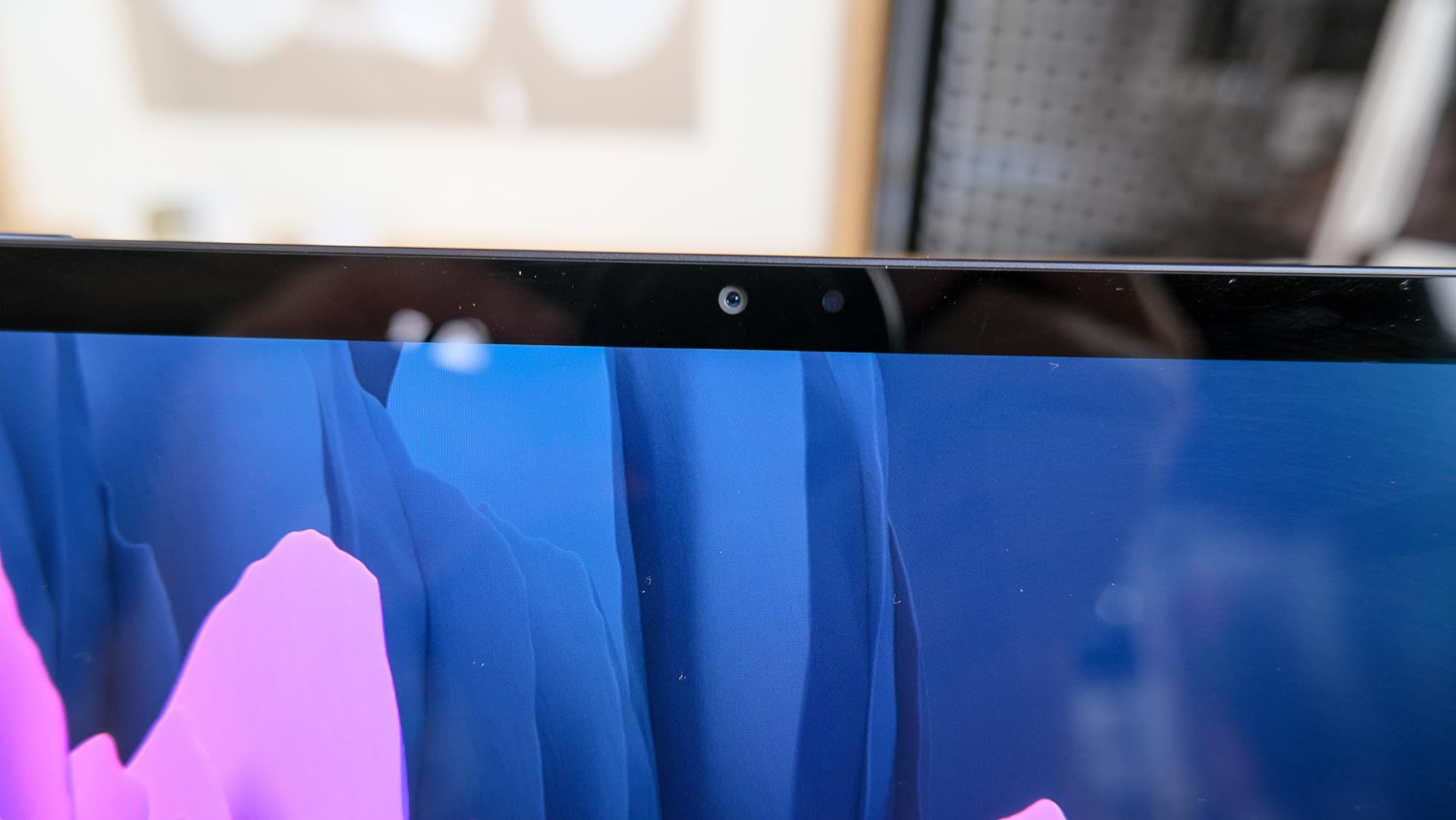
The Tab S7’s rear cameras have a small bump on the back (though it doesn’t look as pronounced as the iPad Pro’s). Fortunately, the tablet doesn’t rock back and forth if you leave it lying down on a table. This micro-issue is even less of a concern for those docking the S Pen on the back, as the stylus is much thicker than the camera bump.
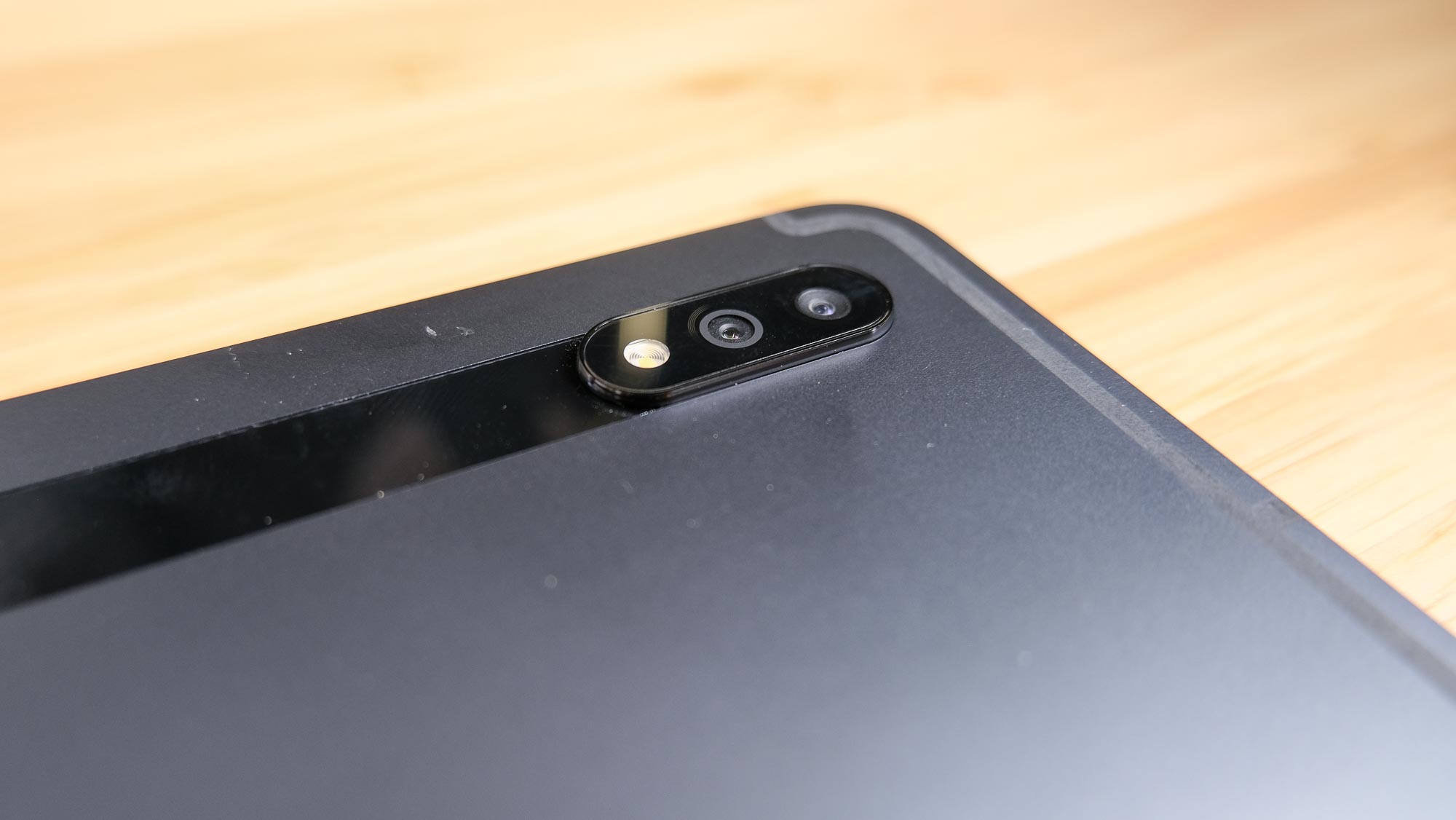
Samsung Galaxy Tab S7 review: Security
The combination of fingerprint reader and facial recognition in the Galaxy Tab S7 gives you a “nearly best of both worlds” situation. I’d prefer it also have the in-screen fingerprint reader that the Tab S7 Plus has, as that’s less awkward to use than the slightly recessed power button that has no visual indicator of its location. You’d get used to it over time, but there’s no fun in “getting used to” anything.
That being said, the Galaxy Tab S7’s fingerprint reader is super-fast, to the point where I am not fast enough with a stopwatch to check how little time it took to authenticate.
The in-bezel facial recognition (another feature familiar to iPad Pro and Surface Pro owners) works better in well-lit rooms, pausing for a bit if you’re in darker spaces like my home office.
Samsung Galaxy Tab S7 review: Software
The Galaxy Tab S7 slates run a version of Android 10 with Samsung’s own user interface tweaks on top. Samsung users tend to like these touches, which have become more refined over the years.
Since note-taking is such a huge part of the tablets and Galaxy Note phones, I’m surprised it took Samsung so long to make its Samsung Notes app sync across its phones, tablets and even its PC app. There’s also an ability to record audio and embed it within a notes file, so you can hear what was being said while you took specific notes.
Samsung Notes also offers to convert handwriting into more legible penmanship. Oddly, the handwriting recognition will place the converted text slightly arbitrarily, as it moved mine to the left side of the PDF I was annotating. The ability to clean up hand-written shapes is welcome (and also in iPadOS 14), but it often kept some of my flaws (i.e. some triangles had small divots).

DeX mode has the same issue that a lot of iPadOS and Android apps apps do: multitasking isn’t quite there yet. For example, when I opened Google Meet, it started with a warning that it might not work perfectly in this mode. When I first tested the Galaxy S7, I was annoyed to see that Meet only worked in full screen mode. Now? It won’t allow me to put it in full screen mode, instead only operating in windowed mode.
My other annoyance is that when you search for apps in DeX mode, I wish the top result could be automatically selected on screen, so a click of the Enter key could open it. Instead, you need to use the keyboard or touchpad, or tap the screen.
DeX mode has a lot to like, though, thanks to some clever moves to the row of buttons on the bottom of the screen. The search/Command button is a fast way to search for apps, and it’s so good that I wish it worked like this in regular Android mode, though it appears Samsung only expects DeX mode to be used when you’re docked with the Book Cover Keyboard.
Another DeX aspect I appreciate is how the apps you’re using stay open in both modes (most of the time). Switching from Samsung’s flavor of Android to DeX, I heard Spotify keep kicking out the sounds of Khalid and Disclosure’s “Talk,” but YouTube videos stopped playing when I moved between them.
Samsung Galaxy Tab S7 review: S-Pen
The new S-Pen doesn’t just come free, but it feels more substantial and more like an actual pen than the flatter versions Samsung gave to past Galaxy Tab slates. As I doodled in Samsung Notes, I noted the speedy input recognition, which Samsung rates at 9ms, tied with the 2nd Gen Apple Pencil.
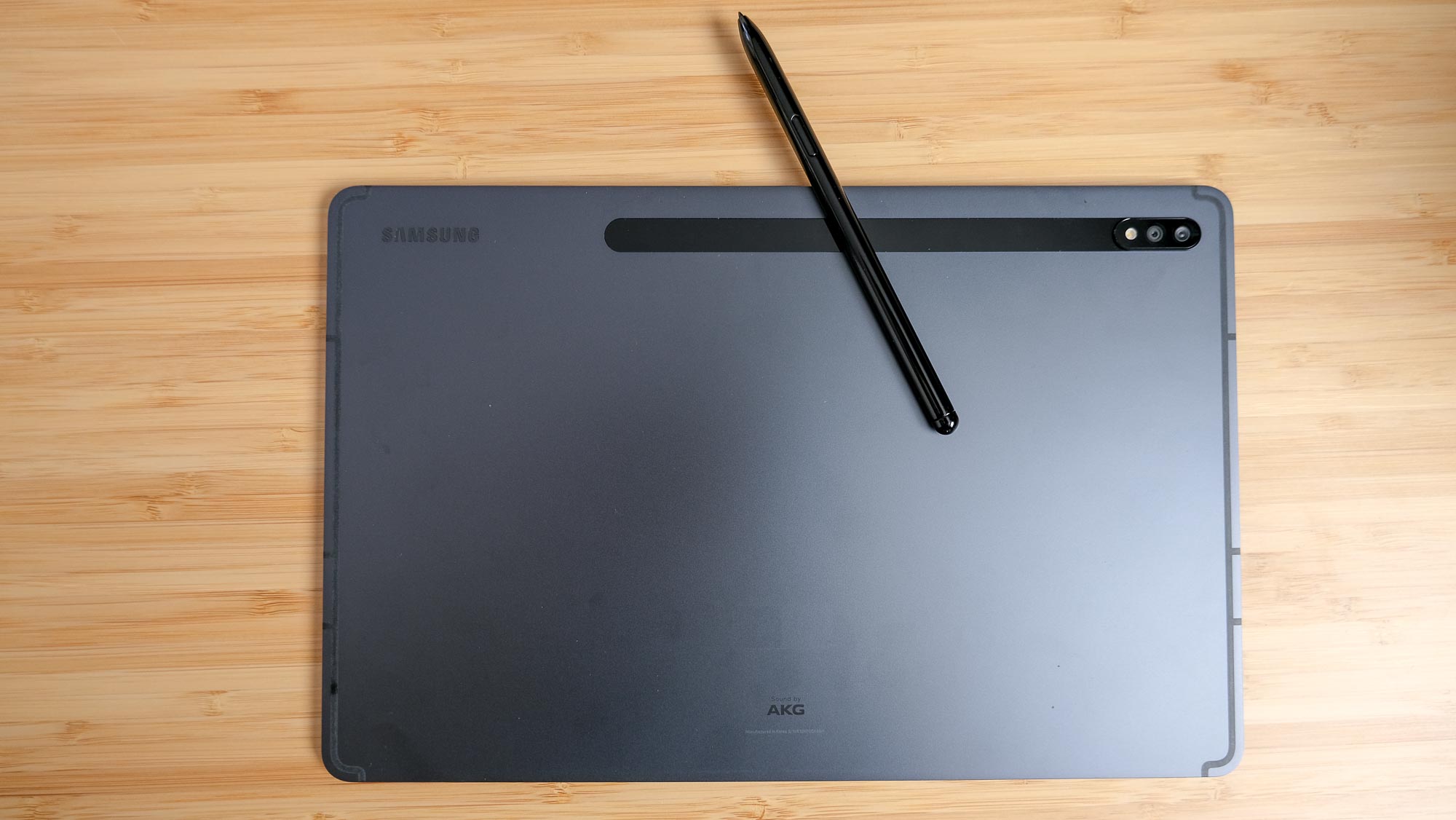
I didn’t like, however, the sound effect of a pencil drawing on paper that came out of the Galaxy Tab S7 as I wrote on it. It’s reminiscent of how cars with quieter engines play fake engine noise out of their speakers. To disable this, I turned down System audio.
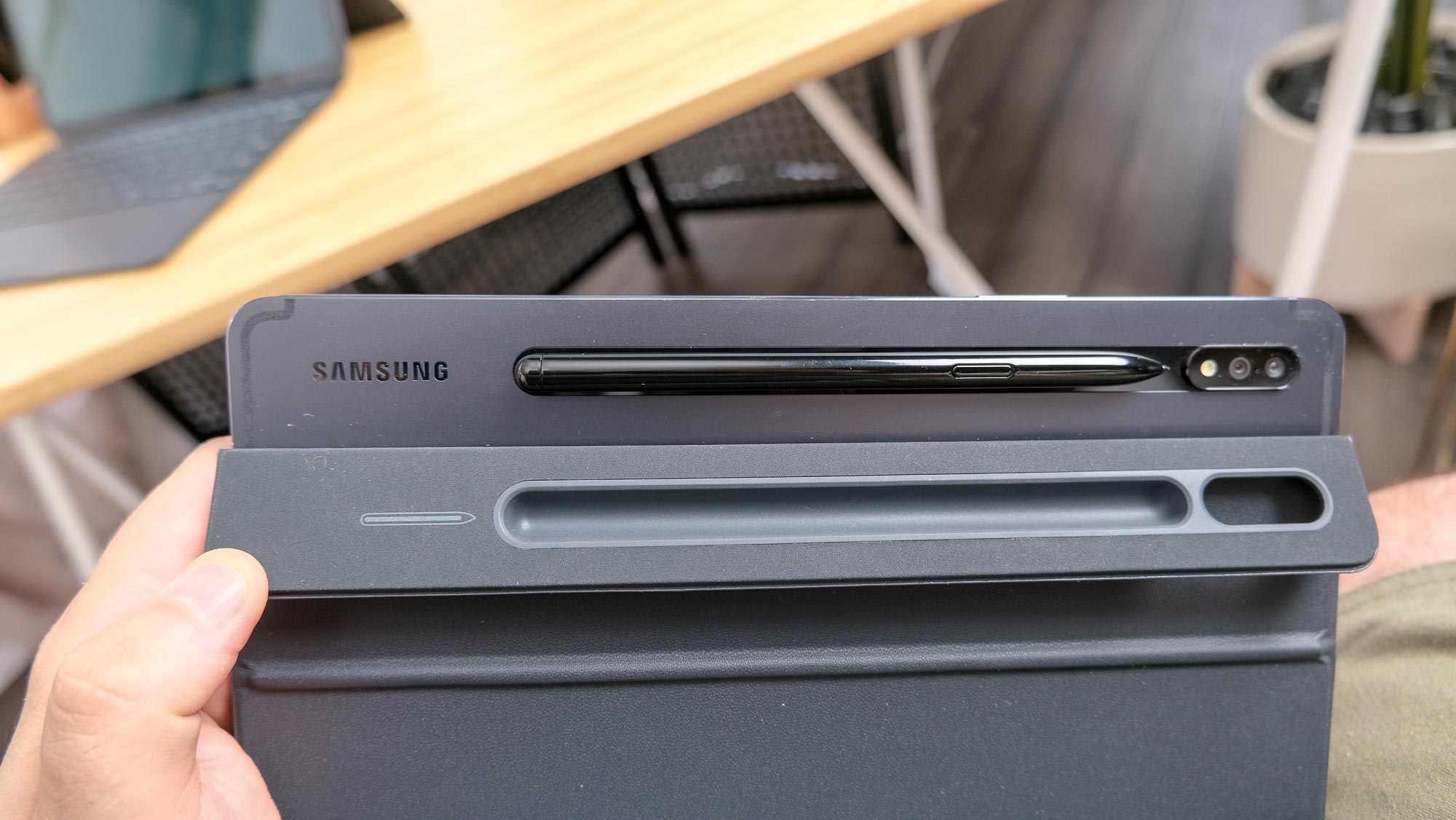
I still prefer Apple’s 2nd Gen Pencil (though I don’t like how it costs $129 extra), because it’s easier to dock and detach that pen. Removing the S Pen requires you either blindly try and pull the S-Pen off the back first, or look over the Tab S7’s back to find it.
Samsung Galaxy Tab S7 review: Book Cover Keyboard
When I tested out the Galaxy Tab S7’s Book Cover Keyboard (a $199 add-on) on the 10fastfingers.com typing test, I clicked my way to 74 words per minute, not too far from my 80 wpm average. This is an especially strong vote of confidence for the keyboard, as I always need time to adjust to keyboard formats I rarely or never use.
Not only is that a respectable speed, but my 94% accuracy rating is a good sign for how great the Tab S7’s Book Cover Keyboard is for typing. Those with smaller fingers may prefer the Tab S7 over the Tab S7 Plus, as the number keys on the S7 are on the smaller side, and the S7 Plus’ number keys are full-sized.
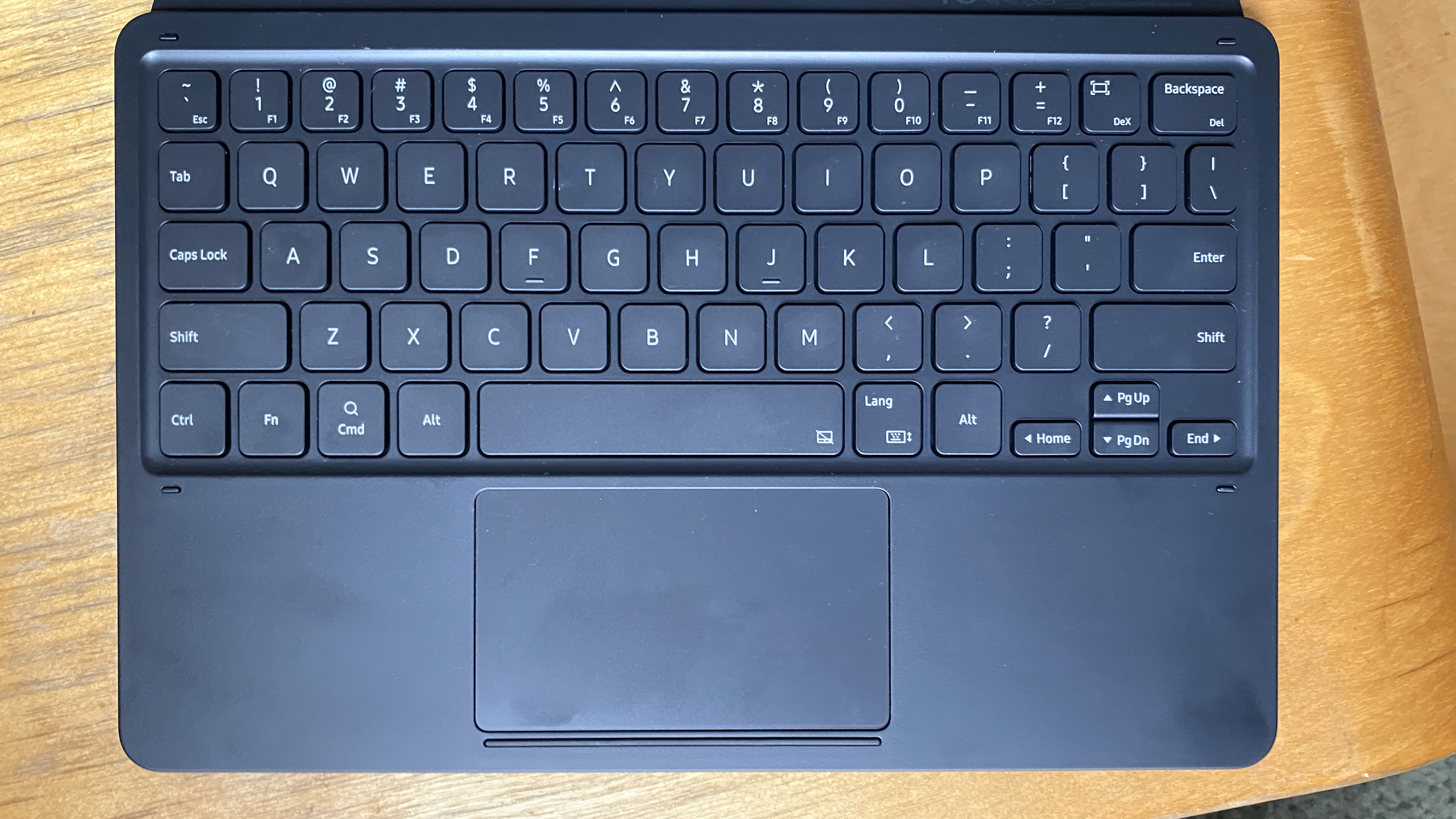
Its touchpad also offers gestures, and there’s a full row of function keys. During my time with the Tab S7 Plus, I noted that the window-switching gestures moved pretty seamlessly.
The only real flaw with the Book Cover Keyboard is that it’s two pieces: the keyboard that sits underside and the back plate that covers the S-Pen and provides as a kickstand. Because when they’re two detachable pieces, breaking the Tab S7 out from the other two is a bit laborious. The Surface Pro 7 and iPad Pro just have one part to dock when it’s typing time.
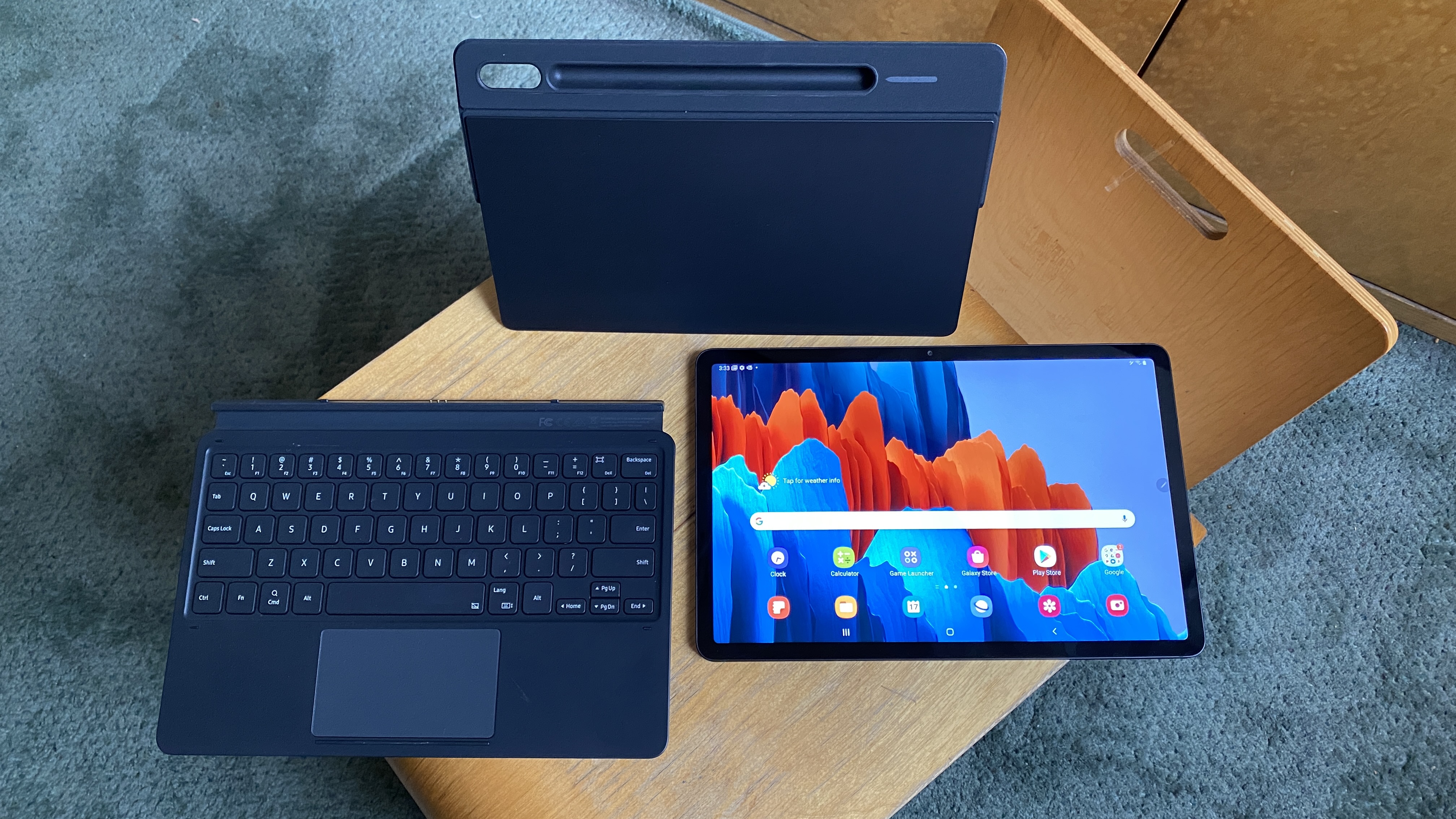
Even though I dislike how the iPad Pro’s Magic Keyboard is $100 to $120 more expensive than the Book Cover Keyboard, I still prefer it. The Magic Keyboard’s not only easier to attach, but its floating and adjustable hinge is easier to move than the Book Cover Keyboard’s kickstand. The Surface Pro 7’s $159 Type Cover is more affordable, but its only real flaw is the lack of a right Ctrl key, which it has in common with the Tab S7.
Samsung Galaxy Tab S7 review: Battery life
The 8,000 mAh battery in the Galaxy Tab S7 provides more than all-day battery life, making it 13 hours and 16 minutes on our Wi-Fi surfing-based battery test. That beats the iPad Pro (10:16) and the iPad Air (10:29) and towers over the time from Surface Pro 7 (7:52) by over 5 hours.
Samsung rates the Galaxy Tab S7 for up to 14 hours of video playback. It also notes that enabling 120Hz refresh rates will cost you some battery life. We look forward to testing the Tab S7 again to see how long it lasts with that enabled.
Samsung Galaxy Tab S7 review: Verdict
Samsung’s been trying to make the Galaxy Tab S-series slates a big deal for a while, and if its recent Tab S6 Lite was the company’s first true home run, the Tab S7 is another homer with a couple of runners on base. From its excellent bright and sharp screen to its top-tier design, this is a tablet that Apple fans may call an iPad Pro clone, but it’s one that Android users need to consider.
If only the Tab S7’s keyboard wasn’t so awkward, and its Snapdragon 865+ could keep up with the big guns that Intel and Apple have trotted out, this could be the best tablet around.
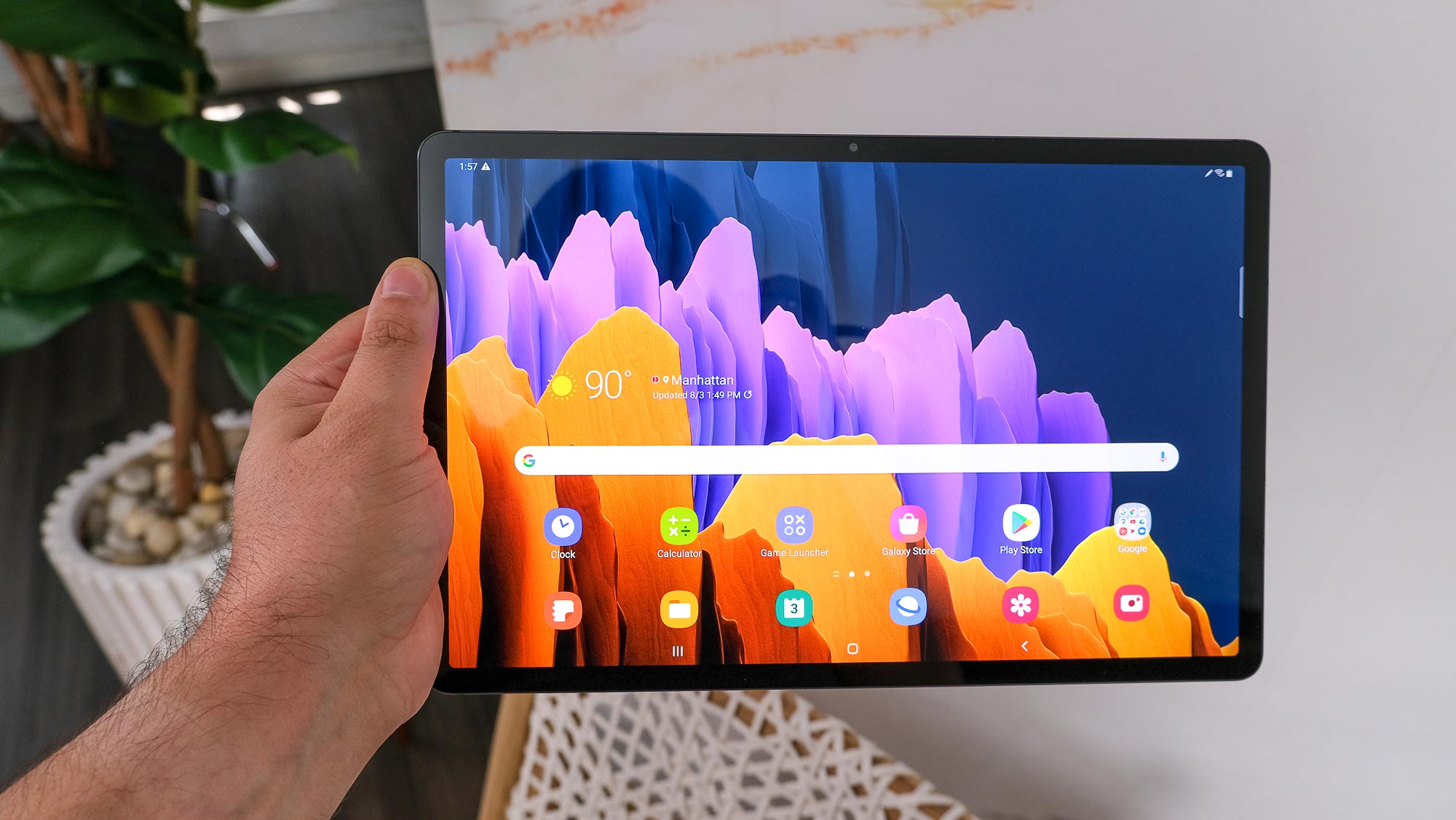
Those looking for speed and tablet-optimized apps should consider the Surface Pro 7, but the Core i5 model we tested costs $460 more at $1,109, and lasts a lot less time on a single charge. And while the iPad Pro’s Magic Keyboard provides a joyful typing experience, the combined package costs $250 more than the Tab S7 with its keyboard — and Apple doesn’t throw in a stylus like Samsung does.
So, for a mid to high-end tablet, we have to give Samsung credit for giving you some serious bang for your buck. We can’t wait to get the Tab S7 Plus tested to see if bigger truly means better.
For all the latest Technology News Click Here
For the latest news and updates, follow us on Google News.
